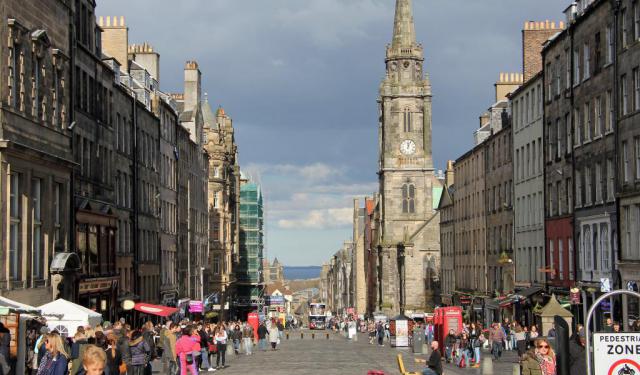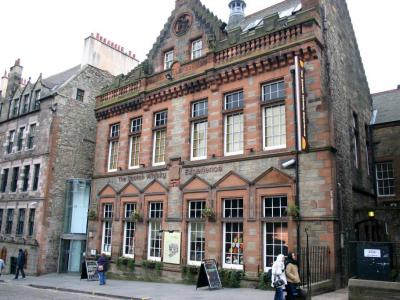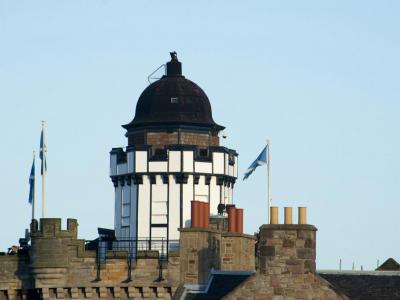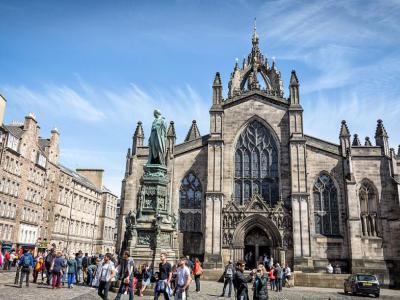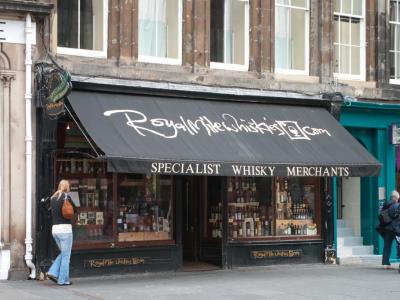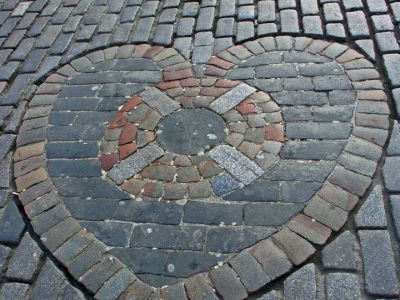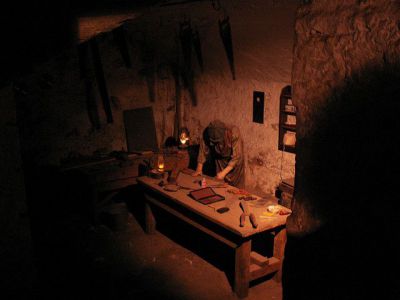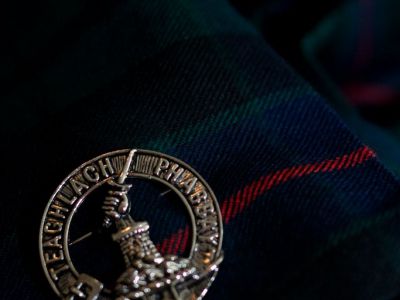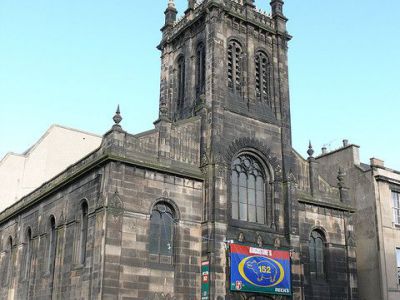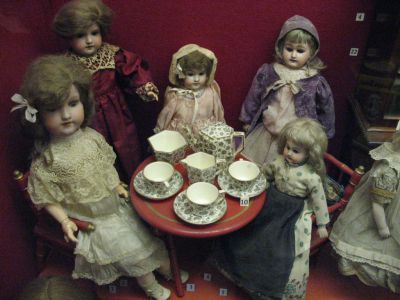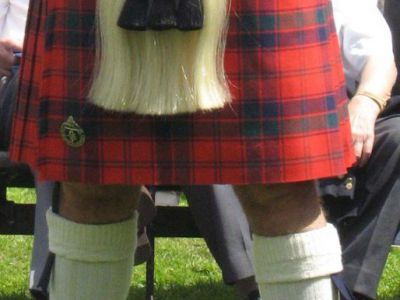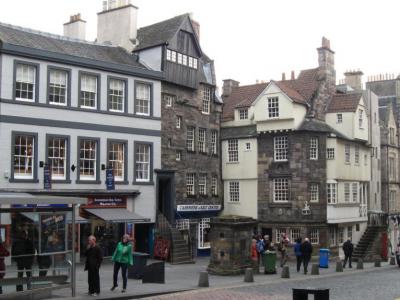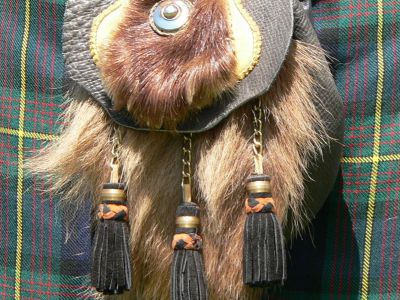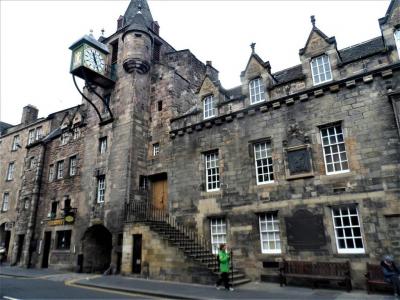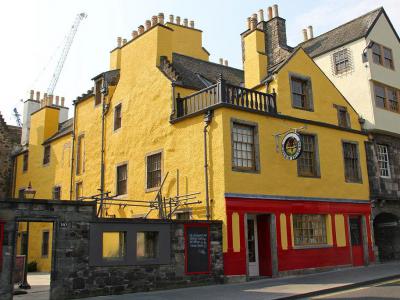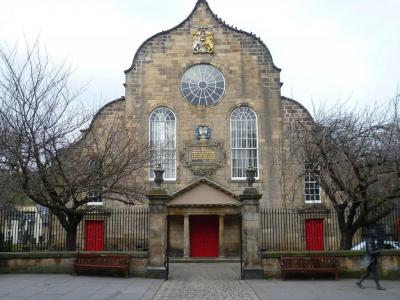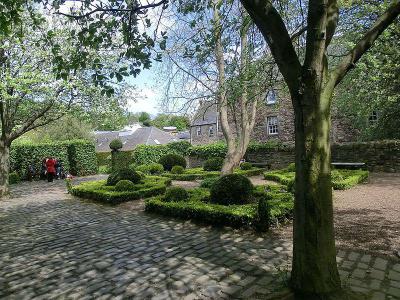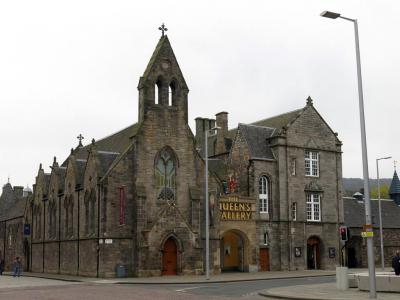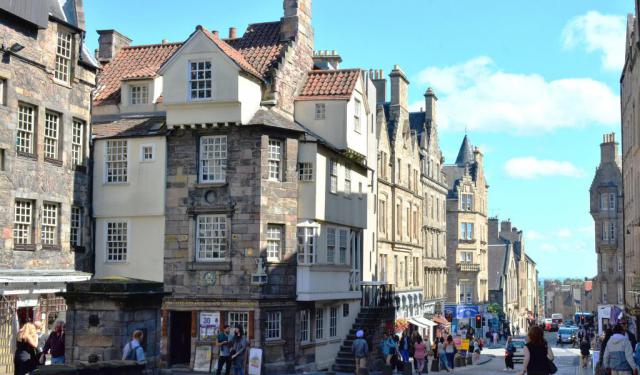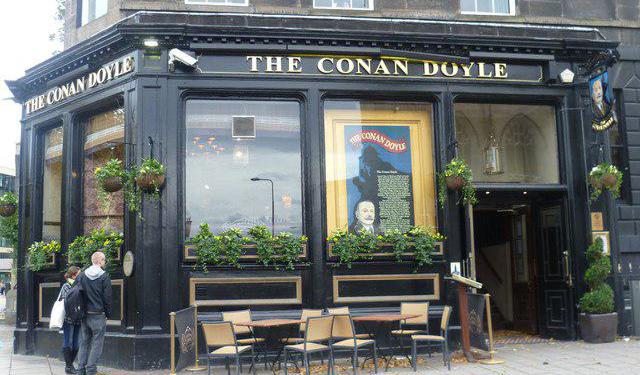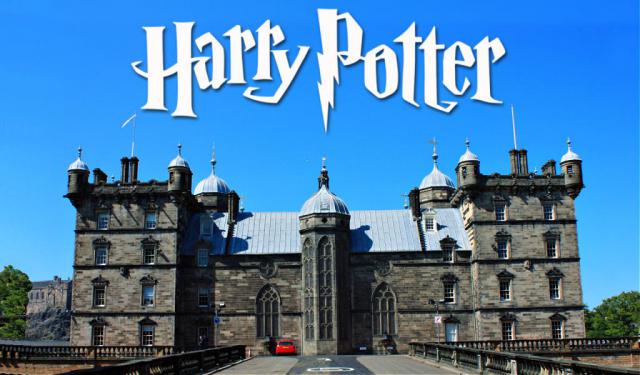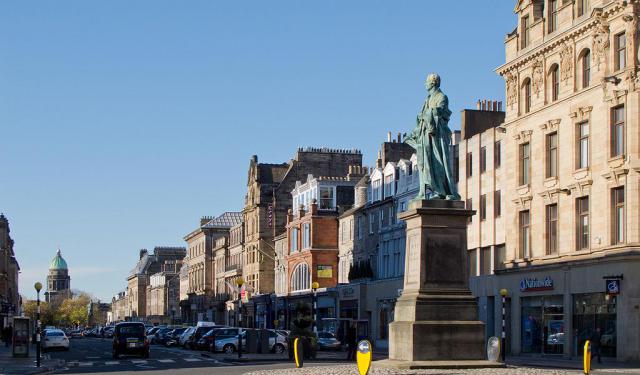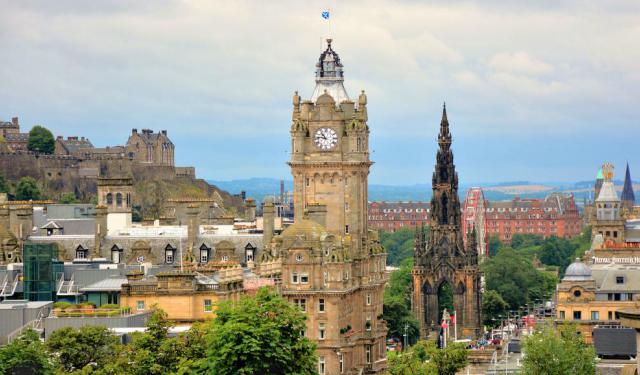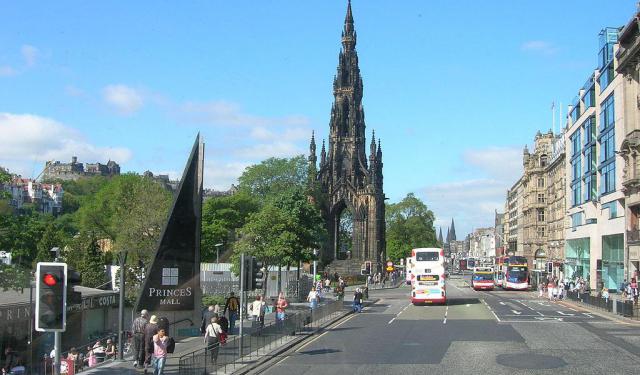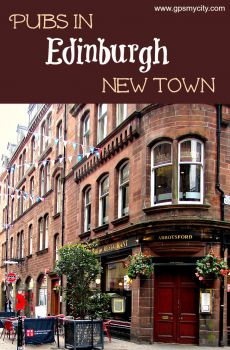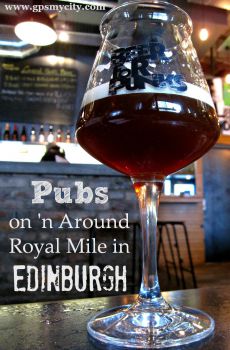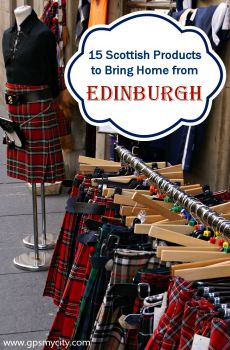Audio Guide: Royal Mile Walking Tour (Self Guided), Edinburgh
The Royal Mile, a steep thoroughfare in the heart of Edinburgh, has served as the city’s backbone since the medieval period. Carved along a volcanic ridge called Castle Rock, this spine of the Old Town slopes down from the mighty Edinburgh Castle at one end to the Holyroodhouse Palace and the weathered ruins of Holyrood Abbey at the other. The distance is almost exactly one Scots mile (hence the name)-which is roughly 1.1 modern miles or 1.8 kilometers-because even back then, Edinburgh liked to do things its own way...
Rolling cobblestones back to the early Middle Ages, the route between the Castle and the Abbey founded by David I in the 1100s was already in business. Filled with merchants, craftsmen, pilgrims, and royalty alike, it quickly became Edinburgh’s main civic and ceremonial artery. Over the centuries, the Mile witnessed pretty much everything-from royal processions and Reformation riots to public executions and Enlightenment debates.
The street's layout-of narrow alleys (known as “closes”) and tall tenements-developed organically, resulting in the densely layered, vertical cityscape that still characterizes the area today (somewhat chaotic and endlessly atmospheric). The term "Royal Mile" itself was coined in the 1920s, when clever tourism promoters realized they had a ready-made brand. Technically, the Mile comprises four streets-such as Castlehill, Lawnmarket, High Street, and Canongate-stitched together into one grand promenade.
Today, the succession of these streets is stuffed with architectural landmarks and a fair bit of haggis-themed souvenirs. Here, St. Giles’ Cathedral, the John Knox House, and the Crest of Edinburgh hold court alongside whisky shops, pubs, and casual eateries, while the Scotch Whisky Experience and Camera Obscura keep the curious entertained with hands-on optical displays and city views.
As you wander, keep an eye out for the Tron Kirk, the Heart of Midlothian mosaic, or the hidden world of Mary King’s Close. The People’s Story Museum and Museum of Edinburgh dig deeper into the city’s past, while the Canongate Kirk offers a quieter reflection. Finish at the Queen’s Gallery, where royal art greets you in suitably regal style.
Indeed, the Royal Mile is less a road and more a time machine-medieval heritage colliding with modern bustle. And when the Edinburgh Festival is in season, it turns into a living carnival of music, theatre, and spectacle. So, take it at your own pace, soak in the sights, and remember: every step here is a stride through centuries.
Rolling cobblestones back to the early Middle Ages, the route between the Castle and the Abbey founded by David I in the 1100s was already in business. Filled with merchants, craftsmen, pilgrims, and royalty alike, it quickly became Edinburgh’s main civic and ceremonial artery. Over the centuries, the Mile witnessed pretty much everything-from royal processions and Reformation riots to public executions and Enlightenment debates.
The street's layout-of narrow alleys (known as “closes”) and tall tenements-developed organically, resulting in the densely layered, vertical cityscape that still characterizes the area today (somewhat chaotic and endlessly atmospheric). The term "Royal Mile" itself was coined in the 1920s, when clever tourism promoters realized they had a ready-made brand. Technically, the Mile comprises four streets-such as Castlehill, Lawnmarket, High Street, and Canongate-stitched together into one grand promenade.
Today, the succession of these streets is stuffed with architectural landmarks and a fair bit of haggis-themed souvenirs. Here, St. Giles’ Cathedral, the John Knox House, and the Crest of Edinburgh hold court alongside whisky shops, pubs, and casual eateries, while the Scotch Whisky Experience and Camera Obscura keep the curious entertained with hands-on optical displays and city views.
As you wander, keep an eye out for the Tron Kirk, the Heart of Midlothian mosaic, or the hidden world of Mary King’s Close. The People’s Story Museum and Museum of Edinburgh dig deeper into the city’s past, while the Canongate Kirk offers a quieter reflection. Finish at the Queen’s Gallery, where royal art greets you in suitably regal style.
Indeed, the Royal Mile is less a road and more a time machine-medieval heritage colliding with modern bustle. And when the Edinburgh Festival is in season, it turns into a living carnival of music, theatre, and spectacle. So, take it at your own pace, soak in the sights, and remember: every step here is a stride through centuries.
How it works: Download the app "GPSmyCity: Walks in 1K+ Cities" from Apple App Store or Google Play Store to your mobile phone or tablet. The app turns your mobile device into a personal tour guide and its built-in GPS navigation functions guide you from one tour stop to next. The app works offline, so no data plan is needed when traveling abroad.
Royal Mile Walking Tour Map
Guide Name: Royal Mile Walking Tour
Guide Location: Scotland » Edinburgh (See other walking tours in Edinburgh)
Guide Type: Self-guided Walking Tour (Sightseeing)
# of Attractions: 17
Tour Duration: 2 Hour(s)
Travel Distance: 1.6 Km or 1 Miles
Author: Helen
Sight(s) Featured in This Guide:
Guide Location: Scotland » Edinburgh (See other walking tours in Edinburgh)
Guide Type: Self-guided Walking Tour (Sightseeing)
# of Attractions: 17
Tour Duration: 2 Hour(s)
Travel Distance: 1.6 Km or 1 Miles
Author: Helen
Sight(s) Featured in This Guide:
- Scotch Whisky Experience
- Camera Obscura and World of Illusions
- St. Giles' Cathedral
- Royal Mile Whiskies
- Heart of Midlothian
- Mary King's Close
- Crest Of Edinburgh
- Tron Kirk Church
- Museum of Childhood
- Geoffrey Taylor Kiltmakers
- John Knox House
- Gordon Nicolson
- People's Story Museum
- Museum of Edinburgh
- Kirk of the Canongate Chapel
- Dunbar's Close Garden
- Queen's Gallery
1) Scotch Whisky Experience (must see)
So, what is the difference between “whisky” and “whiskey”? If that little “e” is driving you to drink, head straight to The Scotch Whisky Experience, where answers-and drams-await. This is Scotland’s answer to Disneyland, but with fewer cartoon mice and significantly more peat smoke.
Indeed, this interactive museum doesn’t just cater to connoisseurs and curious adults. Even the wee (the Scottish word for “little” ones) get a slice of the fun, thanks to “Peat the Cat”-their feline guide through a world of whisky facts and playful games. Meanwhile, the grown-ups hop aboard a moving barrel (yes, you heard that right) for a slow cruise through a mechanical distillery, narrated by none other than the ethereal “Whisky Ghost.” He knows his mash from his malt, and he’s not afraid to share-within reason, of course...
Next stop: the MacIntyre Whisky Gallery, where you'll learn how different flavours are crafted. Well, some of the flavours (trade secrets are revealed only partially...). Then it’s on to the Sense of Scotland room, where your nose gets a full workout sniffing everything from smoky campfires to sweet toffee notes-basically a perfume department for whisky fans.
Your grand finale is the tasting room. Here, you’ll find your whisky-yes, even you who swore you didn’t like the stuff. But do yourself a favour: don’t ask for ice or soda. You’ll get looks colder than the Highlands in January.
Before you stumble out, swing by the gift shop. With over 300 malts and miniatures on offer, it’s practically a whisky library. Tour guests even get a discount-because education should come with perks...
So, in case you're still wondering why go?-Here's the answer: Because where else can you ogle 3,400 unopened bottles of whisky worth a fortune, sip your way through centuries of liquid history, and pair it all with cheese and chocolate that’d make a Highlander weep?
Top Tip:
Spring for the “Gold Tour” if you’re in it for the full whisky safari. And if you're not all that keen on whisky but prefer to look, sniff, and learn without the burn-The “Silver Tour” has your name on it. Slàinte!
Indeed, this interactive museum doesn’t just cater to connoisseurs and curious adults. Even the wee (the Scottish word for “little” ones) get a slice of the fun, thanks to “Peat the Cat”-their feline guide through a world of whisky facts and playful games. Meanwhile, the grown-ups hop aboard a moving barrel (yes, you heard that right) for a slow cruise through a mechanical distillery, narrated by none other than the ethereal “Whisky Ghost.” He knows his mash from his malt, and he’s not afraid to share-within reason, of course...
Next stop: the MacIntyre Whisky Gallery, where you'll learn how different flavours are crafted. Well, some of the flavours (trade secrets are revealed only partially...). Then it’s on to the Sense of Scotland room, where your nose gets a full workout sniffing everything from smoky campfires to sweet toffee notes-basically a perfume department for whisky fans.
Your grand finale is the tasting room. Here, you’ll find your whisky-yes, even you who swore you didn’t like the stuff. But do yourself a favour: don’t ask for ice or soda. You’ll get looks colder than the Highlands in January.
Before you stumble out, swing by the gift shop. With over 300 malts and miniatures on offer, it’s practically a whisky library. Tour guests even get a discount-because education should come with perks...
So, in case you're still wondering why go?-Here's the answer: Because where else can you ogle 3,400 unopened bottles of whisky worth a fortune, sip your way through centuries of liquid history, and pair it all with cheese and chocolate that’d make a Highlander weep?
Top Tip:
Spring for the “Gold Tour” if you’re in it for the full whisky safari. And if you're not all that keen on whisky but prefer to look, sniff, and learn without the burn-The “Silver Tour” has your name on it. Slàinte!
2) Camera Obscura and World of Illusions (must see)
Back in 1835, an entrepreneurial firecracker named Maria Theresa Short decided that Edinburgh needed more science and spectacle. So, she launched what would become the Camera Obscura & World of Illusions, a place where city views met mind-bending visuals long before Instagram filters were a thing.
Short's first venture, called “Short’s Popular Observatory,” was a quirky little spot built from wood, stone, and pure determination up on Calton Hill, near the National Monument. Sadly, the authorities weren’t fans-so, in 1851, they dismantled it. Undeterred, Short relocated to Castlehill, bought the townhouse of the Laird of Cockpen (indeed, this was his name), and stacked two extra floors on top. By 1853, she had rebranded the place as Short’s Observatory, Museum of Science and Art-a title almost as long as the staircase...
In 1892, the venue came under the management of Patrick Geddes, a forward-thinking Scottish urban planner, sociologist, and ecologist, who gave the building a brainy makeover. He renamed it the Outlook Tower and transformed it into a museum and urban study center. In essence, Geddes filled it with a clever vertical geography lesson: the world at the bottom, Europe and English-speaking countries in the middle, and Edinburgh at the top. Crowning it all, in the topmost room, was a Camera Obscura-because, even in the Victorian era, they already wanted something similar to Google Earth!
The museum ceased operations following Geddes' passing in 1932. In 1966, the University of Edinburgh acquired the site with the intention of establishing the Patrick Geddes Centre and archive. However, in 1982, the building changed ownership to private hands, with a one-room tribute to Geddes remaining on the fourth floor. But that's when the real magic was just getting started.
Today, this tower is Edinburgh’s oldest visitor attraction and still the most delightfully dizzying. It features more than 100 interactive exhibits spread across six floors of illusions, holograms, mirror mazes, vortex tunnels, and hands-on wonders. The rooftop terrace is a camera-ready dream with telescopes and skyline views. The original top-floor Camera Obscura is a 19th-century tech marvel that still gives a live, real-time tour of the city below. It's equally educational, entertaining, and just a little surreal-the kind of place where science meets showbiz and your eyeballs never quite know what hit them.
Short's first venture, called “Short’s Popular Observatory,” was a quirky little spot built from wood, stone, and pure determination up on Calton Hill, near the National Monument. Sadly, the authorities weren’t fans-so, in 1851, they dismantled it. Undeterred, Short relocated to Castlehill, bought the townhouse of the Laird of Cockpen (indeed, this was his name), and stacked two extra floors on top. By 1853, she had rebranded the place as Short’s Observatory, Museum of Science and Art-a title almost as long as the staircase...
In 1892, the venue came under the management of Patrick Geddes, a forward-thinking Scottish urban planner, sociologist, and ecologist, who gave the building a brainy makeover. He renamed it the Outlook Tower and transformed it into a museum and urban study center. In essence, Geddes filled it with a clever vertical geography lesson: the world at the bottom, Europe and English-speaking countries in the middle, and Edinburgh at the top. Crowning it all, in the topmost room, was a Camera Obscura-because, even in the Victorian era, they already wanted something similar to Google Earth!
The museum ceased operations following Geddes' passing in 1932. In 1966, the University of Edinburgh acquired the site with the intention of establishing the Patrick Geddes Centre and archive. However, in 1982, the building changed ownership to private hands, with a one-room tribute to Geddes remaining on the fourth floor. But that's when the real magic was just getting started.
Today, this tower is Edinburgh’s oldest visitor attraction and still the most delightfully dizzying. It features more than 100 interactive exhibits spread across six floors of illusions, holograms, mirror mazes, vortex tunnels, and hands-on wonders. The rooftop terrace is a camera-ready dream with telescopes and skyline views. The original top-floor Camera Obscura is a 19th-century tech marvel that still gives a live, real-time tour of the city below. It's equally educational, entertaining, and just a little surreal-the kind of place where science meets showbiz and your eyeballs never quite know what hit them.
3) St. Giles' Cathedral (must see)
Smack in the middle of the Royal Mile, St Giles’ Cathedral-otherwise known as the High Kirk (or High Church) of Edinburgh-isn't one to be missed. The original building went up in the 12th century but didn’t survive a nasty fire-only the central pillars lived to tell the tale. The replacement was built in 1385. Over the years, it had numerous chapels added-known as aisles-resulting in a kind of charming architectural chaos. At one point, the church had over 50 side altars, like a medieval supermarket of holiness...
In 1466, St Giles’ became a collegiate church, which, in 1490, saw the now-iconic, crown-shaped lantern tower completed. During the Reformation, in 1560, things got a bit dramatic. Most of the church’s treasures vanished-stolen, sold, or just spirited away-including its star relic: Saint Giles’ withered arm and hand, complete with a diamond ring on one skeletal finger (macabre bling at its finest...). In addition to that, the church was partitioned by walls into multiple preaching zones-a kind of Protestant “feng shui,” if you will...
Despite being called a cathedral, it only technically wore that title twice, briefly, during the 17th-century Bishop Wars. The statute of “High Kirk” remains its real claim to fame. A 19th-century restoration gave the church a glow-up-partitions were removed and several chapels pulled down. Among the surviving chapels, perhaps the most beautiful is the Thistle Chapel from 1911: a jaw-dropping High Gothic gem dripping in wood and stone carvings, fluttering heraldic banners, and a breathtaking, delicately carved vaulted ceiling.
Once here, look out for a bronze plaque to Robert Louis Stevenson, author of Treasure Island, in the Moray Aisle, a marble tribute to the dashing but doomed 1st Marquis of Montrose, in the Chapman Aisle, and another to his bitter rival, Archibald Campbell, the 1st Marquis of Argyll, in the Saint Eloi Aisle. Fun fact: these two, once the main signatories of the National Covenant in 1638 (the document signed to oppose attempts to impose Anglican religious practices on the Church of Scotland), became sworn enemies towards the end of their lives. Edinburgh drama, anyone?
Aside from all that, the place is absolutely gorgeous, packed to the rim with stained glass beauty. You’ll walk out with neck cramp from all the ceiling admiration-and it’ll be worth it.
Pro tips:
Entry is free or by donation, but if you’re planning a photo shoot, prepare to fork over £2 for a "permit".
Best to get onto a tour, as there's much you could miss just wandering on your own. Also, if you're feeling adventurous, take the rooftop tour (worth £6).
And yes-don't miss a cozy café downstairs that serves tasty bites. Praise be!
In 1466, St Giles’ became a collegiate church, which, in 1490, saw the now-iconic, crown-shaped lantern tower completed. During the Reformation, in 1560, things got a bit dramatic. Most of the church’s treasures vanished-stolen, sold, or just spirited away-including its star relic: Saint Giles’ withered arm and hand, complete with a diamond ring on one skeletal finger (macabre bling at its finest...). In addition to that, the church was partitioned by walls into multiple preaching zones-a kind of Protestant “feng shui,” if you will...
Despite being called a cathedral, it only technically wore that title twice, briefly, during the 17th-century Bishop Wars. The statute of “High Kirk” remains its real claim to fame. A 19th-century restoration gave the church a glow-up-partitions were removed and several chapels pulled down. Among the surviving chapels, perhaps the most beautiful is the Thistle Chapel from 1911: a jaw-dropping High Gothic gem dripping in wood and stone carvings, fluttering heraldic banners, and a breathtaking, delicately carved vaulted ceiling.
Once here, look out for a bronze plaque to Robert Louis Stevenson, author of Treasure Island, in the Moray Aisle, a marble tribute to the dashing but doomed 1st Marquis of Montrose, in the Chapman Aisle, and another to his bitter rival, Archibald Campbell, the 1st Marquis of Argyll, in the Saint Eloi Aisle. Fun fact: these two, once the main signatories of the National Covenant in 1638 (the document signed to oppose attempts to impose Anglican religious practices on the Church of Scotland), became sworn enemies towards the end of their lives. Edinburgh drama, anyone?
Aside from all that, the place is absolutely gorgeous, packed to the rim with stained glass beauty. You’ll walk out with neck cramp from all the ceiling admiration-and it’ll be worth it.
Pro tips:
Entry is free or by donation, but if you’re planning a photo shoot, prepare to fork over £2 for a "permit".
Best to get onto a tour, as there's much you could miss just wandering on your own. Also, if you're feeling adventurous, take the rooftop tour (worth £6).
And yes-don't miss a cozy café downstairs that serves tasty bites. Praise be!
4) Royal Mile Whiskies
Wondering what to buy in Edinburgh? Whisky, of course-malt Scotch whisky to be precise. And honestly, there’s no better address for it than the Royal Mile. If you’re hunting for a gift that won’t just gather dust on a shelf, a bottle of single malt will do the trick. This isn’t just Scotland’s pride and joy-it is also the country’s biggest export. Edinburgh even hosts the Malt Whisky Society, home to the largest whisky collection on the planet.
Enter Royal Mile Whiskies, a shop that’s been making a name for itself since 1991. And not just any name, either-they’ve scooped up Whisky Magazine’s “Retailer of the Year” more times than most distilleries have casks. Step inside, and you’ll find yourself in the company of staff who don’t just sell whisky-they live and breathe it. These folks can spot a hesitant beginner and an overconfident connoisseur at twenty paces, and they’ll happily talk barrels, peat, and barley until you feel like part of the clan.
The selection? Let’s just say it’s world-class. From Scotland’s legendary distilleries to rarities you didn’t even know existed, the shelves here carry liquid history in every bottle. Some are everyday drams that start around 30 bucks a bottle, while others, priced north of 1500, might require you to whisper “investment” to your bank account. Either way, each bottle has a story-and chances are, the staff will pour you a sample and tell it.
So, whether you leave with a humble dram or a collector’s masterpiece, Royal Mile Whiskies delivers exactly what it promises: Scotland in a glass, ready to travel home with you.
Enter Royal Mile Whiskies, a shop that’s been making a name for itself since 1991. And not just any name, either-they’ve scooped up Whisky Magazine’s “Retailer of the Year” more times than most distilleries have casks. Step inside, and you’ll find yourself in the company of staff who don’t just sell whisky-they live and breathe it. These folks can spot a hesitant beginner and an overconfident connoisseur at twenty paces, and they’ll happily talk barrels, peat, and barley until you feel like part of the clan.
The selection? Let’s just say it’s world-class. From Scotland’s legendary distilleries to rarities you didn’t even know existed, the shelves here carry liquid history in every bottle. Some are everyday drams that start around 30 bucks a bottle, while others, priced north of 1500, might require you to whisper “investment” to your bank account. Either way, each bottle has a story-and chances are, the staff will pour you a sample and tell it.
So, whether you leave with a humble dram or a collector’s masterpiece, Royal Mile Whiskies delivers exactly what it promises: Scotland in a glass, ready to travel home with you.
5) Heart of Midlothian
Walking the Royal Mile, you might stumble upon one of Edinburgh’s strange traditions-strange, if not say bizarre, and frankly, a little unhygienic... Just outside the west door of St. Giles’ Cathedral, locals casually spit on a heart-shaped mosaic set into the cobblestones. Don’t worry, they’re not insulting romance-it’s the Heart of Midlothian, and the spit is meant to bring good luck. Just be careful to keep out of range, as you draw closer...
This mosaic marks the site of the Old Tolbooth, a building that once served as the city’s customs house, a meeting hall (briefly used by the Estates of Scotland), and, most infamously, a prison. Yes, back in 1640, it housed the Court of Session, the principal jail of the burgh. And this was no cozy jail at all: the Tolbooth gained a fearsome reputation for torture, trials, and public executions carried out right at its front door. Not exactly the kind of spot you’d put on a postcard...
Legend has it that Edinburgh’s less-than-law-abiding citizens started the spitting custom themselves. Passing through the Tolbooth doors on their way to trial or worse, the petty thieves and not-so-petty criminals spat for luck-though in truth, it probably didn’t help much.
The Tolbooth was demolished in 1817, but the Heart remains, just as yet another stop for tourists dodging loogies. It now serves as a reminder that beneath the charm of the Royal Mile lie centuries of grit, misery, and gallows humor. So, if you see the heart, step wide-and maybe think twice before following tradition.
This mosaic marks the site of the Old Tolbooth, a building that once served as the city’s customs house, a meeting hall (briefly used by the Estates of Scotland), and, most infamously, a prison. Yes, back in 1640, it housed the Court of Session, the principal jail of the burgh. And this was no cozy jail at all: the Tolbooth gained a fearsome reputation for torture, trials, and public executions carried out right at its front door. Not exactly the kind of spot you’d put on a postcard...
Legend has it that Edinburgh’s less-than-law-abiding citizens started the spitting custom themselves. Passing through the Tolbooth doors on their way to trial or worse, the petty thieves and not-so-petty criminals spat for luck-though in truth, it probably didn’t help much.
The Tolbooth was demolished in 1817, but the Heart remains, just as yet another stop for tourists dodging loogies. It now serves as a reminder that beneath the charm of the Royal Mile lie centuries of grit, misery, and gallows humor. So, if you see the heart, step wide-and maybe think twice before following tradition.
6) Mary King's Close (must see)
If ghost stories give you chills in a good way, then Real Mary King’s Close might just be your perfect haunt in Edinburgh. Tucked beneath the Royal Exchange, this underground maze of shadowy alleyways and crumbling tenement rooms has a reputation for being one of the most haunted corners of the city-and in Edinburgh, that’s saying something...
Originally a bustling neighborhood, the close was sealed off after the Great Plague of 1645 rolled into town, carried by flea-infested rats from merchant ships. With zero plumbing and not a bar of soap in sight, these cramped quarters became ground zero for infection. In a desperate attempt to contain the spread, entire blocks-predominantly the poorer areas, including Mary King’s Close-were bricked in as urgent quarantine measures. Legend has it, some unlucky souls were trapped inside at the mercy of plague or starvation... and they never left. At least, not in spirit.
One ghost in particular likes to make her presence known: Annie, a small girl, who is said to have lost her doll-and possibly much more-when the plague swept through. Visitors claim to feel her presence, and many bring her gifts: toys, trinkets, or coins, all of which are passed on to children’s hospitals and local charities. So, even the ghostly get a little goodwill...
The area was uncovered during renovations to the Royal Exchange and was opened to the public in 2003 as a tourist attraction. Since then, costumed guides have been leading brave guests through these 17th-century underground time capsules, sharing tales of the little Annie and Mary King-a respected businesswoman and seamstress after whom it is named-as well as the dark chapters etched into every cobbled corner.
So, if you’re in the mood for a little historical horror with a charitable twist, Mary King’s Close is calling. Just... don’t forget Annie’s doll.
Originally a bustling neighborhood, the close was sealed off after the Great Plague of 1645 rolled into town, carried by flea-infested rats from merchant ships. With zero plumbing and not a bar of soap in sight, these cramped quarters became ground zero for infection. In a desperate attempt to contain the spread, entire blocks-predominantly the poorer areas, including Mary King’s Close-were bricked in as urgent quarantine measures. Legend has it, some unlucky souls were trapped inside at the mercy of plague or starvation... and they never left. At least, not in spirit.
One ghost in particular likes to make her presence known: Annie, a small girl, who is said to have lost her doll-and possibly much more-when the plague swept through. Visitors claim to feel her presence, and many bring her gifts: toys, trinkets, or coins, all of which are passed on to children’s hospitals and local charities. So, even the ghostly get a little goodwill...
The area was uncovered during renovations to the Royal Exchange and was opened to the public in 2003 as a tourist attraction. Since then, costumed guides have been leading brave guests through these 17th-century underground time capsules, sharing tales of the little Annie and Mary King-a respected businesswoman and seamstress after whom it is named-as well as the dark chapters etched into every cobbled corner.
So, if you’re in the mood for a little historical horror with a charitable twist, Mary King’s Close is calling. Just... don’t forget Annie’s doll.
7) Crest Of Edinburgh
Keep an eye out on the Royal Mile for a riot of tartan-kilts, scarves, even the occasional plaid-clad dog mannequin. That’s your cue, you’ve landed at the Crest of Edinburgh, a compact shop crammed with all things Scottish attire. Inside, the racks groan with tartan and tweed, but the real treasures are the clan-crested Highland accessories-like sporrans (those leather/fur pouches worn at the front of a kilt to hold personal items), cufflinks, sgian dubhs (which means "black knives" or "black daggers" in Scottish Gaelic), and, of course, the star of the show: Scottish crest badges.
These little emblems aren’t just shiny souvenirs. They’re heraldic badges, each one pairing a clan crest with a motto, traditionally worn to signal allegiance to a chief. Think of it as a wearable family banner, in silver or white metal, polished up to pin proudly on your lapel-or, if you’re following tradition, as a brooch on the left side. Women often wear them as a statement piece, but they look just as sharp on a kilt jacket.
Now, a fun fact: the crests technically belong to the clan chief, not just every member, but that doesn’t stop anyone from snapping them up. Prices range from 20 to 150 dollars apiece, depending on how fancy you want to go. So, if you’re looking for a gift that screams Scotland without literally screaming, a crest badge is a clever choice-heritage, sparkle, and a dash of Highland pride all in one pin...
These little emblems aren’t just shiny souvenirs. They’re heraldic badges, each one pairing a clan crest with a motto, traditionally worn to signal allegiance to a chief. Think of it as a wearable family banner, in silver or white metal, polished up to pin proudly on your lapel-or, if you’re following tradition, as a brooch on the left side. Women often wear them as a statement piece, but they look just as sharp on a kilt jacket.
Now, a fun fact: the crests technically belong to the clan chief, not just every member, but that doesn’t stop anyone from snapping them up. Prices range from 20 to 150 dollars apiece, depending on how fancy you want to go. So, if you’re looking for a gift that screams Scotland without literally screaming, a crest badge is a clever choice-heritage, sparkle, and a dash of Highland pride all in one pin...
8) Tron Kirk Church
Ambling down Edinburgh’s Royal Mile-castle behind you, Holyrood ahead, then, on your left-you’re bound to spot The Tron Kirk. It doesn’t exactly shout for attention these days, but in its prime, back in the 17th century, this once beautiful church was a royal commission from King Charles I himself. Architect John Mylne threw in a mix of Palladian and Gothic styles with a Dutch twist, thanks to his admiration for Hendrick de Keyser’s “Architectura moderna.” The result was a bold T-shaped design that fit the trendy religious fashions of the time.
Of course, nothing in Edinburgh stays untouched for long. By 1787, the South Bridge arrived, and the Tron got a makeover. Then in 1820, its wooden spire went up in flames-literally-only to be replaced in 1828 by the stone tower you see today. From there, its fate grew stranger: deconsecrated in 1952, the building has been used for various purposes-from a tourist information centre to the headquarters of the Black Heart Entertainment company, which organizes ghost tours.
Dig a little deeper-again, literally-and you’ll find more surprises. In the 1970s, archaeologists poking around the crypt uncovered the remains of Marlin’s Wynd with splendid vaulted cellars of an old building and part of a medieval street still intact. It’s a rare chance to step back into the hidden layers of Edinburgh whenever the building is open to the public.
And yet, the Tron Kirk’s story isn’t fully settled. For decades, it has been the subject of raging arguments: whether to restore it or wreck it? While the city debates, the building quietly slips further into decay. A pity, really-because losing this landmark would erase not just bricks and mortar, but centuries of Edinburgh’s restless, reinventing spirit.
Of course, nothing in Edinburgh stays untouched for long. By 1787, the South Bridge arrived, and the Tron got a makeover. Then in 1820, its wooden spire went up in flames-literally-only to be replaced in 1828 by the stone tower you see today. From there, its fate grew stranger: deconsecrated in 1952, the building has been used for various purposes-from a tourist information centre to the headquarters of the Black Heart Entertainment company, which organizes ghost tours.
Dig a little deeper-again, literally-and you’ll find more surprises. In the 1970s, archaeologists poking around the crypt uncovered the remains of Marlin’s Wynd with splendid vaulted cellars of an old building and part of a medieval street still intact. It’s a rare chance to step back into the hidden layers of Edinburgh whenever the building is open to the public.
And yet, the Tron Kirk’s story isn’t fully settled. For decades, it has been the subject of raging arguments: whether to restore it or wreck it? While the city debates, the building quietly slips further into decay. A pity, really-because losing this landmark would erase not just bricks and mortar, but centuries of Edinburgh’s restless, reinventing spirit.
9) Museum of Childhood
Tired of dragging the kids through yet another castle or gallery where the only thing they can touch is the “Exit” sign? Then it’s time to swap stone walls for teddy bears at the Museum of Childhood on the Royal Mile.
This place owes its existence to Patrick Murray, a forward-thinking Edinburgh councillor in the 1950s who noticed children weren’t exactly thrilled to be hauled into draughty museums on rainy days. His solution was to build a museum entirely about childhood-school, play, health, and above all, toys. By 1955, his dream opened its doors, offering something that could entertain both fidgety kids and their weary parents.
Inside, five floors of nostalgia and discovery are waiting. There’s an Education section where kids can peer into classrooms from the 1950s onwards, complete with old uniforms and the infamous birch rod-yes, the one used for “discipline.” But don’t worry, this museum has swapped punishment for play. Around the corner, there’s a dressing-up room, a puppet theatre, and, naturally, toys galore.
From dolls and teddy bears to tin soldiers with matchstick cannons, train sets, and board games, the displays stretch across centuries and continents. Children can see what kept their parents and grandparents happy before the age of screens, while adults are quietly hit with a wave of nostalgia they themselves find hard to admit to.
And when you think the fun is over, the toy shop on the ground floor will remind you otherwise. Kids can pick out a new favourite, and grown-ups might even find a stand-in for that long-lost teddy they still think about.
Why visit, if you're all by yourself? Because this isn’t just a family stop-it’s a time machine filled with joy. Entry is free, though donation boxes and quirky souvenirs await near the exit. Consider it pocket money well spent...
This place owes its existence to Patrick Murray, a forward-thinking Edinburgh councillor in the 1950s who noticed children weren’t exactly thrilled to be hauled into draughty museums on rainy days. His solution was to build a museum entirely about childhood-school, play, health, and above all, toys. By 1955, his dream opened its doors, offering something that could entertain both fidgety kids and their weary parents.
Inside, five floors of nostalgia and discovery are waiting. There’s an Education section where kids can peer into classrooms from the 1950s onwards, complete with old uniforms and the infamous birch rod-yes, the one used for “discipline.” But don’t worry, this museum has swapped punishment for play. Around the corner, there’s a dressing-up room, a puppet theatre, and, naturally, toys galore.
From dolls and teddy bears to tin soldiers with matchstick cannons, train sets, and board games, the displays stretch across centuries and continents. Children can see what kept their parents and grandparents happy before the age of screens, while adults are quietly hit with a wave of nostalgia they themselves find hard to admit to.
And when you think the fun is over, the toy shop on the ground floor will remind you otherwise. Kids can pick out a new favourite, and grown-ups might even find a stand-in for that long-lost teddy they still think about.
Why visit, if you're all by yourself? Because this isn’t just a family stop-it’s a time machine filled with joy. Entry is free, though donation boxes and quirky souvenirs await near the exit. Consider it pocket money well spent...
10) Geoffrey Taylor Kiltmakers
Now, if you’ve ever fancied strutting down the Royal Mile looking like you just stepped out of Scottish history-or a whisky commercial-it's time to buy yourself a kilt or a tartan scarf. And in that case, Geoffrey Tailor Kiltmakers is the place to do it. Since 1971, when Geoffrey, the Master Tailor, and his wife Lorna set up shop, this family-run business has been one of the big names in authentic Highland dress. We’re talking kilts made to measure, head-to-toe ensembles, and accessories for men, women, and even kids. Basically, if it can be worn to a ceilidh (which is a Scottish folk music party with a lot of traditional singing and dancing involved) or a castle, they’ve got you covered.
And here’s the fun part-they don’t just sell you a kilt, they can design an entire tartan just for you only-on real powerlooms! Think of it as couture, but with more bagpipes... Indeed, they’ve crafted tartans for Harley Davidson, Hard Rock Café, Edinburgh Castle, and even Holyrood Palace. When it comes to pedigree, you’re in solid hands here. Quality is the rule, not the exception-so no knock-offs or “plastic tartans” in sight. Prices are anywhere between $40 and $450 apiece, depending on what you’re after.
Of course, if a full kilt feels a bit… ambitious, there’s always the trusty tartan scarf. These beauties come in wool, silk, and cashmere, and they don’t just keep you warm-they make you look like you belong in a portrait. Men, women, children, even dogs (well, unofficially)-a tartan scarf suits everyone. Wear it wrapped, draped, or flung casually over your shoulder like you’ve got a castle waiting back home. Prices range from $10 to $200, which means you can grab one as a stylish souvenir or splash out on something truly luxurious.
So, whether you’re kilt-curious or just scarf-hunting, Geoffrey Tailor Kiltmakers is where Scottish tradition meets a bit of panache...
And here’s the fun part-they don’t just sell you a kilt, they can design an entire tartan just for you only-on real powerlooms! Think of it as couture, but with more bagpipes... Indeed, they’ve crafted tartans for Harley Davidson, Hard Rock Café, Edinburgh Castle, and even Holyrood Palace. When it comes to pedigree, you’re in solid hands here. Quality is the rule, not the exception-so no knock-offs or “plastic tartans” in sight. Prices are anywhere between $40 and $450 apiece, depending on what you’re after.
Of course, if a full kilt feels a bit… ambitious, there’s always the trusty tartan scarf. These beauties come in wool, silk, and cashmere, and they don’t just keep you warm-they make you look like you belong in a portrait. Men, women, children, even dogs (well, unofficially)-a tartan scarf suits everyone. Wear it wrapped, draped, or flung casually over your shoulder like you’ve got a castle waiting back home. Prices range from $10 to $200, which means you can grab one as a stylish souvenir or splash out on something truly luxurious.
So, whether you’re kilt-curious or just scarf-hunting, Geoffrey Tailor Kiltmakers is where Scottish tradition meets a bit of panache...
11) John Knox House
If you’ve ever wanted to nose around someone else’s house without feeling guilty, house museums are your perfect excuse. Not only do you get a peek at old furniture trends and fancy ceilings, but you also get a dose of juicy historical gossip. And when it comes to John Knox House on the Royal Mile, the stories are just as layered as the timber beams.
Dating back to around 1490, this charming survivor is the oldest house on the Royal Mile-and it’s not shy about showing off. We’re talking hand-painted ceilings, oak beams that have seen things, and a wooden gallery or two that creak with character. Now owned by the Church of Scotland, it was once home to James Mossman, a royal goldsmith. Given that he fashioned not just one but two crowns-one for Mary, Queen of Scots, and another for her son, King James VI-it’s safe to say that this house has seen some sparkle.
Now, here’s the twist: whether John Knox, the renowned 16th-century Protestant Reformer, himself actually lived here is contested-a kind of Medieval real estate marketing... In the 1700s, the place was severely dilapidated and was saved from demolition by the Society of Antiquaries of Scotland, who casually floated the rumour that this had been Knox’s humble abode. Voilà-instant historical landmark!
Inside, the museum is a magnet for anyone even mildly interested in religious history and the Reformation in particular. There are numerous manuscripts, relics, and even papers Knox himself tucked away in a time capsule. Plus, as part of the Scottish Storytelling Centre, the place brings history alive with costumed guides and interactive exhibits. There’s even a special room for children where they can don a John Knox costume and solve puzzles-because, among many other things, family fun includes dressing up as a 16th-century firebrand...
So, go ahead, walk through the creaky floors, raise an eyebrow at the painted ceilings, and decide for yourself-was this Knox’s house, or just a really good story? Either way, it’s worth stepping inside.
Dating back to around 1490, this charming survivor is the oldest house on the Royal Mile-and it’s not shy about showing off. We’re talking hand-painted ceilings, oak beams that have seen things, and a wooden gallery or two that creak with character. Now owned by the Church of Scotland, it was once home to James Mossman, a royal goldsmith. Given that he fashioned not just one but two crowns-one for Mary, Queen of Scots, and another for her son, King James VI-it’s safe to say that this house has seen some sparkle.
Now, here’s the twist: whether John Knox, the renowned 16th-century Protestant Reformer, himself actually lived here is contested-a kind of Medieval real estate marketing... In the 1700s, the place was severely dilapidated and was saved from demolition by the Society of Antiquaries of Scotland, who casually floated the rumour that this had been Knox’s humble abode. Voilà-instant historical landmark!
Inside, the museum is a magnet for anyone even mildly interested in religious history and the Reformation in particular. There are numerous manuscripts, relics, and even papers Knox himself tucked away in a time capsule. Plus, as part of the Scottish Storytelling Centre, the place brings history alive with costumed guides and interactive exhibits. There’s even a special room for children where they can don a John Knox costume and solve puzzles-because, among many other things, family fun includes dressing up as a 16th-century firebrand...
So, go ahead, walk through the creaky floors, raise an eyebrow at the painted ceilings, and decide for yourself-was this Knox’s house, or just a really good story? Either way, it’s worth stepping inside.
12) Gordon Nicolson
Wondering why bother with a sporran?-Because even the proudest Highland kilt needs somewhere to stash your keys, coins, and other personal items...
Enter Gordon Nicolson Kiltmakers, a small family business with a big mission: to revive Scotland’s endangered national craft and keep tartan alive and kicking. Since 2016, they’ve also run the Edinburgh Kilt Academy, which means this isn’t just a shop-it’s part workshop, part classroom, and all heart. Their exclusive tartans, reputedly among the best in town, are the stuff of legend: University of Edinburgh, John Muir Way, Flodden, Celtic F.C., the Scotland National Team-you name it. All tartans are exclusively designed, registered, and woven by Gordon Nicolson Kiltmakers, offering a great deal of personalisation.
Of course, kilts-be it regular and clan tartan kilts-are just the beginning. Step inside and you’ll also find the full Highlandwear arsenal, including Prince Charlie jackets, argylls, tweed waistcoats (available in fetching green, blue, and brown tweeds), ghillie brogues, kilt hose and pins, trews-and yes, rows upon rows of sporrans. Think of the sporran as the Highlander’s handbag, only with more swagger...
Made from leather or fur and ranging from understated daywear to lavish horsehair creations, sporrans are as practical as they are stylish. There are dress sporrans, day sporrans, animal mask sporrans-something for every level of formality, from ceilidh to state banquet. And prices? They start around the cost of a good pub lunch and climb all the way into heirloom territory (from $15 up to $650, or more). Whether you’re buying a keepsake for yourself or a gift that shouts “Scotland!” louder than bagpipes at dawn, the sporran is your pocketless kilt’s best friend!
Enter Gordon Nicolson Kiltmakers, a small family business with a big mission: to revive Scotland’s endangered national craft and keep tartan alive and kicking. Since 2016, they’ve also run the Edinburgh Kilt Academy, which means this isn’t just a shop-it’s part workshop, part classroom, and all heart. Their exclusive tartans, reputedly among the best in town, are the stuff of legend: University of Edinburgh, John Muir Way, Flodden, Celtic F.C., the Scotland National Team-you name it. All tartans are exclusively designed, registered, and woven by Gordon Nicolson Kiltmakers, offering a great deal of personalisation.
Of course, kilts-be it regular and clan tartan kilts-are just the beginning. Step inside and you’ll also find the full Highlandwear arsenal, including Prince Charlie jackets, argylls, tweed waistcoats (available in fetching green, blue, and brown tweeds), ghillie brogues, kilt hose and pins, trews-and yes, rows upon rows of sporrans. Think of the sporran as the Highlander’s handbag, only with more swagger...
Made from leather or fur and ranging from understated daywear to lavish horsehair creations, sporrans are as practical as they are stylish. There are dress sporrans, day sporrans, animal mask sporrans-something for every level of formality, from ceilidh to state banquet. And prices? They start around the cost of a good pub lunch and climb all the way into heirloom territory (from $15 up to $650, or more). Whether you’re buying a keepsake for yourself or a gift that shouts “Scotland!” louder than bagpipes at dawn, the sporran is your pocketless kilt’s best friend!
13) People's Story Museum
Learning about Scotland’s royalty and nobles is all very interesting, but sometimes you may wonder-what life was like for the ordinary folk, while kings and queens were busy strutting about in their finery? The answer can be found at the People’s Story Museum, and it’s far more down-to-earth, sometimes quite literally...
Housed in Canongate Tolbooth, a formidable 16th-century building that once doubled as a customs house and a jail, its walls have witnessed a thing or two. Nowadays, instead of keeping smugglers and prisoners in, it keeps the stories of everyday Edinburgh, as seen through the eyes of those who lived and worked here from the 1700s right up to modern times.
Once inside, you’ll be whisked through a series of beautifully recreated spaces such as a bookbinder’s shop where ink stains were badges of honour, a pub where gossip flowed as freely as the beer, a prison cell where nobody wanted to linger, a dainty tea-room, and even a wartime kitchen, where “making do” was a daily survival skill. Copies of the original objects, complete with photographs, drawings, and artefacts, tie it all together, giving you an unpolished but very real glimpse into how ordinary people lived their lives.
There’s a section on Edinburgh Life that shows communities pulling together-and sometimes pulling no punches in rallies and protests against injustice. Another area, Working in Edinburgh, tips its hat to the trades that kept the city ticking in the 18th and 19th centuries-books, beer, and cakes, the essentials of civilization. The Leith Collection focuses on shipyard labour, while the Newhaven Collection dips into the salty world of the fishing community. And “At Home in Edinburgh” takes you right into the living rooms stocked with furniture, crockery, toys, and domestic appliances, including even record players-nostalgia included...
Best of all, the museum is wonderfully kid-friendly, partly because it lets them discover a time before smartphones and MP4 players were a thing. Yes, there really was life without TikTok... To round it all off, the museum shop offers books and gift items related to objects on display, thus allowing visitors to take home a little slice of Edinburgh’s working-class past, without the prison sentence...
Housed in Canongate Tolbooth, a formidable 16th-century building that once doubled as a customs house and a jail, its walls have witnessed a thing or two. Nowadays, instead of keeping smugglers and prisoners in, it keeps the stories of everyday Edinburgh, as seen through the eyes of those who lived and worked here from the 1700s right up to modern times.
Once inside, you’ll be whisked through a series of beautifully recreated spaces such as a bookbinder’s shop where ink stains were badges of honour, a pub where gossip flowed as freely as the beer, a prison cell where nobody wanted to linger, a dainty tea-room, and even a wartime kitchen, where “making do” was a daily survival skill. Copies of the original objects, complete with photographs, drawings, and artefacts, tie it all together, giving you an unpolished but very real glimpse into how ordinary people lived their lives.
There’s a section on Edinburgh Life that shows communities pulling together-and sometimes pulling no punches in rallies and protests against injustice. Another area, Working in Edinburgh, tips its hat to the trades that kept the city ticking in the 18th and 19th centuries-books, beer, and cakes, the essentials of civilization. The Leith Collection focuses on shipyard labour, while the Newhaven Collection dips into the salty world of the fishing community. And “At Home in Edinburgh” takes you right into the living rooms stocked with furniture, crockery, toys, and domestic appliances, including even record players-nostalgia included...
Best of all, the museum is wonderfully kid-friendly, partly because it lets them discover a time before smartphones and MP4 players were a thing. Yes, there really was life without TikTok... To round it all off, the museum shop offers books and gift items related to objects on display, thus allowing visitors to take home a little slice of Edinburgh’s working-class past, without the prison sentence...
14) Museum of Edinburgh
If you're meandering down the Royal Mile and wondering where to get your history fix with a side of scandal, the Museum of Edinburgh is your spot. Housed in the delightfully crooked 16th-century Huntly House-once the home of the city’s hammer-wielding Guild of Hammermen-this place is Edinburgh’s memory palace, packed with everything from Roman relics to rogue biographies.
Inside, you’ll find numerous silverware that practically glows with civic pride, glassware engraved just down the road in Canongate, some pottery that’s almost too pretty to have survived Scottish winters, and a Sedan chair that reminds us how people once got carried away-literally. There are also clocks so stately they make your smartwatch feel wildly inadequate. And don’t miss the costume corner, where you're invited to play dress-up through the ages. Georgian elegance? Victorian gloom? Just pick your century.
Among the many treasures, you’ll stumble across fragments from a 1st-century Roman settlement dug up in Cramond-yes, the Romans beat the tourists to this small village north-west of Edinburgh by about 2,000 years. You’ll also lay eyes on the original National Covenant (that’s serious ink), James Craig’s neatly sketched vision for the New Town, and even Greyfriars Bobby’s food bowl and collar-proof that loyalty earns you legend status in this city.
There is also a “rogues’ gallery” of sorts, where Edinburgh’s darker side grins back at you. Meet Deacon Brodie, respectable tradesman by day, burglar by night-basically Jekyll and Hyde, with better tailoring. And don’t forget Burke and Hare, the notorious body snatchers who supplied fresh corpses to Dr. Knox of the Medicine University, no questions asked...
So, yes, the Museum of Edinburgh has all the drama, dignity, and delightful weirdness this city’s history has to offer-and then some...
Inside, you’ll find numerous silverware that practically glows with civic pride, glassware engraved just down the road in Canongate, some pottery that’s almost too pretty to have survived Scottish winters, and a Sedan chair that reminds us how people once got carried away-literally. There are also clocks so stately they make your smartwatch feel wildly inadequate. And don’t miss the costume corner, where you're invited to play dress-up through the ages. Georgian elegance? Victorian gloom? Just pick your century.
Among the many treasures, you’ll stumble across fragments from a 1st-century Roman settlement dug up in Cramond-yes, the Romans beat the tourists to this small village north-west of Edinburgh by about 2,000 years. You’ll also lay eyes on the original National Covenant (that’s serious ink), James Craig’s neatly sketched vision for the New Town, and even Greyfriars Bobby’s food bowl and collar-proof that loyalty earns you legend status in this city.
There is also a “rogues’ gallery” of sorts, where Edinburgh’s darker side grins back at you. Meet Deacon Brodie, respectable tradesman by day, burglar by night-basically Jekyll and Hyde, with better tailoring. And don’t forget Burke and Hare, the notorious body snatchers who supplied fresh corpses to Dr. Knox of the Medicine University, no questions asked...
So, yes, the Museum of Edinburgh has all the drama, dignity, and delightful weirdness this city’s history has to offer-and then some...
15) Kirk of the Canongate Chapel
The Kirk of the Canongate Chapel is the church attended by British monarchs whenever they are in town, taking residence at Holyrood Palace. From the outside, you might think it’s just another unassuming stone church-plain, modest, almost shy. But once inside, it’s like walking into a totally different world, full of colour, light, and carefully crafted details. That surprise is part of its charm.
The chapel was built in the late 1600s, designed by master mason James Smith. Its look is simple but refined: a rectangular body topped with a Dutch-style end gable, and a Doric columned portico giving it a touch of classical elegance. Right outside, you’ll see a bronze statue of Robert Fergusson-the 18th-century poet immortalized mid-stride, forever keeping an eye on the comings and goings of the Canongate.
Now, here’s where it gets ceremonial. The chapel is tied to the Order of the Thistle, which is the highest order of Scotland’s chivalry. Although the Order's official chapel is found inside St. Giles Cathedral, investitures and other grand ceremonies have been staged here, at the Kirk of Canongate, in even-numbered years since the reign of King James II. It’s tradition with a twist-part sacred, part royal pomp...
Over the centuries, the church has changed several times. First remodelled in 1882 with galleries and a central pulpit, it was then stripped back to something closer to its original form after World War II. Restoration between 1946 and 1954 reopened the apse, while a new pipe organ, installed in 1988, filled the space with music worthy of its history.
Inside, the chapel doesn’t hold back. The cruciform layout feels light and airy, the walls gleam white, and the pews shine in sky blue. Look closer and you’ll spot rainbow-coloured cushions in the apse, bright banners hanging above, and a bold red carpet tying it all together. Indeed, for a place that hides behind a modest exterior, the Kirk of the Canongate is full of surprises once you cross the threshold...
The chapel was built in the late 1600s, designed by master mason James Smith. Its look is simple but refined: a rectangular body topped with a Dutch-style end gable, and a Doric columned portico giving it a touch of classical elegance. Right outside, you’ll see a bronze statue of Robert Fergusson-the 18th-century poet immortalized mid-stride, forever keeping an eye on the comings and goings of the Canongate.
Now, here’s where it gets ceremonial. The chapel is tied to the Order of the Thistle, which is the highest order of Scotland’s chivalry. Although the Order's official chapel is found inside St. Giles Cathedral, investitures and other grand ceremonies have been staged here, at the Kirk of Canongate, in even-numbered years since the reign of King James II. It’s tradition with a twist-part sacred, part royal pomp...
Over the centuries, the church has changed several times. First remodelled in 1882 with galleries and a central pulpit, it was then stripped back to something closer to its original form after World War II. Restoration between 1946 and 1954 reopened the apse, while a new pipe organ, installed in 1988, filled the space with music worthy of its history.
Inside, the chapel doesn’t hold back. The cruciform layout feels light and airy, the walls gleam white, and the pews shine in sky blue. Look closer and you’ll spot rainbow-coloured cushions in the apse, bright banners hanging above, and a bold red carpet tying it all together. Indeed, for a place that hides behind a modest exterior, the Kirk of the Canongate is full of surprises once you cross the threshold...
16) Dunbar's Close Garden
Shopping and sightseeing in the Royal Mile can be tiring, so if you don’t feel like having lunch in a crowded pub or restaurant, grab a packed lunch or pick up a sandwich, and sneak off to Dunbar’s Close Garden. Tucked near the Canongate Kirkyard, this hidden gem is one of those places that makes you feel like you’ve just fallen through a medieval trapdoor.
Dunbar’s Close is one of about 80 medieval alleys still threading their way through the Old Town. At the end of it lies a garden that feels like it was designed for time travel. Truly a secret garden, many locals don’t even know it exists, which means you can enjoy your lunch here in peace.
The garden is surrounded by high, ancient stone walls shutting out the noise. The plot is long and rather narrow, with three-quarters of an acre laid out in a proper 17th-century style, featuring gravel paths and beds of herbs, shrubs, and flowers neatly bordered by ting hedges. Conical topiary points the way, while mature fig and sycamore trees lean in to offer a bit of shade over stone benches-perfect for a quiet pause or some light sandwich meditation.
The garden’s story adds another layer. It was created by Sir Patrick Geddes, a visionary biologist who dreamed of filling Edinburgh with pocket gardens like this. Sadly, he passed away shortly after Dunbar’s Close Garden was completed. By the 1970s, the place had gone wild from neglect.
Luckily, around that time, the Mushroom Trust-a charity promoting the creation of urban green spaces-took over the garden and asked landscape architect Seamus Filor to bring it back to life. In 1977, the Trust gifted the restored garden to the city, and by 1978, it was open to the public. So now, whenever you need a break from tartan overload while in Edinburgh, you’ve got your own secret garden waiting...
Dunbar’s Close is one of about 80 medieval alleys still threading their way through the Old Town. At the end of it lies a garden that feels like it was designed for time travel. Truly a secret garden, many locals don’t even know it exists, which means you can enjoy your lunch here in peace.
The garden is surrounded by high, ancient stone walls shutting out the noise. The plot is long and rather narrow, with three-quarters of an acre laid out in a proper 17th-century style, featuring gravel paths and beds of herbs, shrubs, and flowers neatly bordered by ting hedges. Conical topiary points the way, while mature fig and sycamore trees lean in to offer a bit of shade over stone benches-perfect for a quiet pause or some light sandwich meditation.
The garden’s story adds another layer. It was created by Sir Patrick Geddes, a visionary biologist who dreamed of filling Edinburgh with pocket gardens like this. Sadly, he passed away shortly after Dunbar’s Close Garden was completed. By the 1970s, the place had gone wild from neglect.
Luckily, around that time, the Mushroom Trust-a charity promoting the creation of urban green spaces-took over the garden and asked landscape architect Seamus Filor to bring it back to life. In 1977, the Trust gifted the restored garden to the city, and by 1978, it was open to the public. So now, whenever you need a break from tartan overload while in Edinburgh, you’ve got your own secret garden waiting...
17) Queen's Gallery
The King's Gallery, previously known as The Queen’s Gallery, opened in 2002 to mark Queen Elizabeth II’s Golden Jubilee. This royal splash of culture in Edinburgh-tucked right beside the Scottish Parliament and Holyrood Park-is part of the Palace of Holyroodhouse and is set within the Palace Mews. But here's the twist: the gallery was built inside the shell of a Victorian church and school that once stood at the Palace gates. Talk about a second life-one moment sermons, the next moment storage space, and now? Regal art on display...
Originally, this little building housed a church which once belonged to the Free Church of Scotland, and later the United Free Church, hosting worship until 1915. After that, it became more broom cupboard than cathedral-right until Queen Elizabeth II herself cut the ribbon and gave it its current royal role.
Inside, the gallery rotates treasures from the Royal Collection, including paintings, jewels, furniture, and the occasional surprise object you didn’t even know you needed to see. The exhibitions change regularly, so even if you’ve been here before, you’ll likely spot something new the next time.
And it’s not just about looking, either. The gallery doubles as a classroom with workshops for kids and school groups-in portrait drawing, landscape sketching in the Palace gardens, even model-making. It’s art history all right, but hands-on and a little more fun than your average lecture.
And when the masterpieces have left you cross-eyed, there’s a café bar next door. Because nothing says “royal day out” like a cup of tea after admiring a few centuries’ worth of crown-approved creativity...
Originally, this little building housed a church which once belonged to the Free Church of Scotland, and later the United Free Church, hosting worship until 1915. After that, it became more broom cupboard than cathedral-right until Queen Elizabeth II herself cut the ribbon and gave it its current royal role.
Inside, the gallery rotates treasures from the Royal Collection, including paintings, jewels, furniture, and the occasional surprise object you didn’t even know you needed to see. The exhibitions change regularly, so even if you’ve been here before, you’ll likely spot something new the next time.
And it’s not just about looking, either. The gallery doubles as a classroom with workshops for kids and school groups-in portrait drawing, landscape sketching in the Palace gardens, even model-making. It’s art history all right, but hands-on and a little more fun than your average lecture.
And when the masterpieces have left you cross-eyed, there’s a café bar next door. Because nothing says “royal day out” like a cup of tea after admiring a few centuries’ worth of crown-approved creativity...
Walking Tours in Edinburgh, Scotland
Create Your Own Walk in Edinburgh
Creating your own self-guided walk in Edinburgh is easy and fun. Choose the city attractions that you want to see and a walk route map will be created just for you. You can even set your hotel as the start point of the walk.
Old Town Walking Tour
Edinburgh’s Old Town isn’t just old-it’s ancient, smoky, and proud of itself. This is the city’s historic core, where centuries of drama, diplomacy, and architectural ambition come layered in stone, soot, and scandal. From its Celtic roots to Roman incursions and royal power plays, this part of town has seen more plot twists than a binge-worthy period drama.
At the heart of it all lies... view more
Tour Duration: 2 Hour(s)
Travel Distance: 2.5 Km or 1.6 Miles
At the heart of it all lies... view more
Tour Duration: 2 Hour(s)
Travel Distance: 2.5 Km or 1.6 Miles
Literary Landmarks Tour
For centuries, Edinburgh has been home to numerous writers. The likes of Robert Burns, Robert Louis Stevenson, and JK Rowling, just to name a few, have given pride to this city. Fortunately, the tradition doesn't seem to die out any time soon, as Edinburgh keeps producing more and more authors and literary heroes in whose footsteps people still wish to tread.
Naturally, there is a wealth... view more
Tour Duration: 1 Hour(s)
Travel Distance: 2.9 Km or 1.8 Miles
Naturally, there is a wealth... view more
Tour Duration: 1 Hour(s)
Travel Distance: 2.9 Km or 1.8 Miles
Harry Potter Trail
Years after the last Harry Potter book hit the shelves and the last movie rolled its credits, the cultural phenomenon of Harry Potter doesn't seem to fade away, and the fandom continues strong as ever. Although by now Harry Potter has become a household name across the globe, his literary roots are right here in Edinburgh.
Indeed, J.K. Rowling wrote much of the saga in Scotland’s... view more
Tour Duration: 2 Hour(s)
Travel Distance: 2.6 Km or 1.6 Miles
Indeed, J.K. Rowling wrote much of the saga in Scotland’s... view more
Tour Duration: 2 Hour(s)
Travel Distance: 2.6 Km or 1.6 Miles
New Town Walking Tour
Rightly regarded as the historic masterpiece of city planning, the New Town of Edinburgh has been a UNESCO World Heritage Site since 1995. The area forms a significant part of the Scottish capital and is known for its elegant Georgian architecture, abundant shopping opportunities, and many other delights firmly associated with this city.
One of the prominent landmarks in the New Town is... view more
Tour Duration: 2 Hour(s)
Travel Distance: 2.5 Km or 1.6 Miles
One of the prominent landmarks in the New Town is... view more
Tour Duration: 2 Hour(s)
Travel Distance: 2.5 Km or 1.6 Miles
Edinburgh Introduction Walking Tour
If you like cities with a split personality, Edinburgh is definitely one such, featuring a striking mix of medieval and Georgian architecture. Indeed, here medieval grit meets Enlightenment wit, and every cobbled incline has a story to tell-whether your legs are ready for it or not. Perched (or more like wedged) across volcanic hills, the city has been Scotland’s capital since the 15th century... view more
Tour Duration: 2 Hour(s)
Travel Distance: 3.4 Km or 2.1 Miles
Tour Duration: 2 Hour(s)
Travel Distance: 3.4 Km or 2.1 Miles
Famous Squares and Streets Walking Tour
Being in Edinburgh, it is only natural to be curious about the avenues, boulevards, and streets leading to (or stemming from) the city's picturesque squares. There, you can find a copious amount of historic and religious sites, fashion stores, classy restaurants, and marketplaces, not to mention some hidden gems, exploring which is well worth the time spent.
One of Edinburgh's most... view more
Tour Duration: 2 Hour(s)
Travel Distance: 2.9 Km or 1.8 Miles
One of Edinburgh's most... view more
Tour Duration: 2 Hour(s)
Travel Distance: 2.9 Km or 1.8 Miles
Useful Travel Guides for Planning Your Trip
19 Best Pubs in New Town, Edinburgh
A guide to the pubs that make up the area that is called Edinburgh's New Town. A description about what you can expect from each of the locations in the directory. A fantastic directory if you are a tourist or even a...
Top 12 Pubs On and Around Royal Mile in Edinburgh
Edinburgh is a vibrant city with abundant nightlife and no shortage of places to go after dusk. The Royal Mile alone, in the very heart of Edinburgh, is laden with character spots craving to be discovered by the first time visitors to the city. This is the highlight of some of the most notable bars...
Scottish Souvenirs: 15 Authentic Scottish Things to Buy in Edinburgh
The popularity of Scotland stretches far beyond its geographical borders, fueled, in large part, by Hollywood's interest in the Scottish theme - Sean Connery (as James Bond), "Braveheart", etc. Indeed, the cultural spectrum of this part of Britain is enormous and comprises great...
The Most Popular Cities
/ view all
